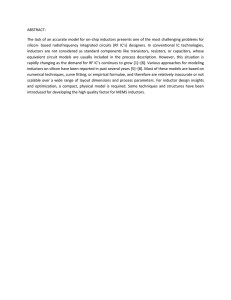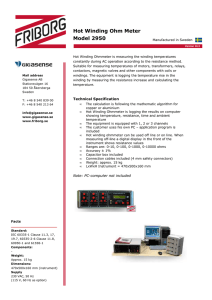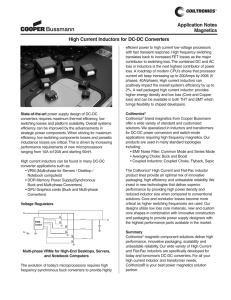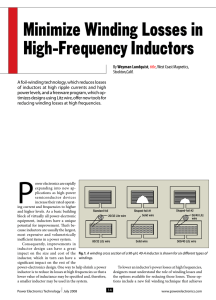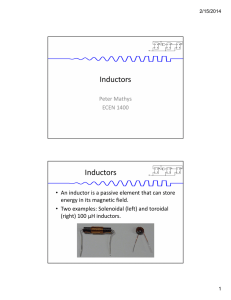as a PDF
advertisement
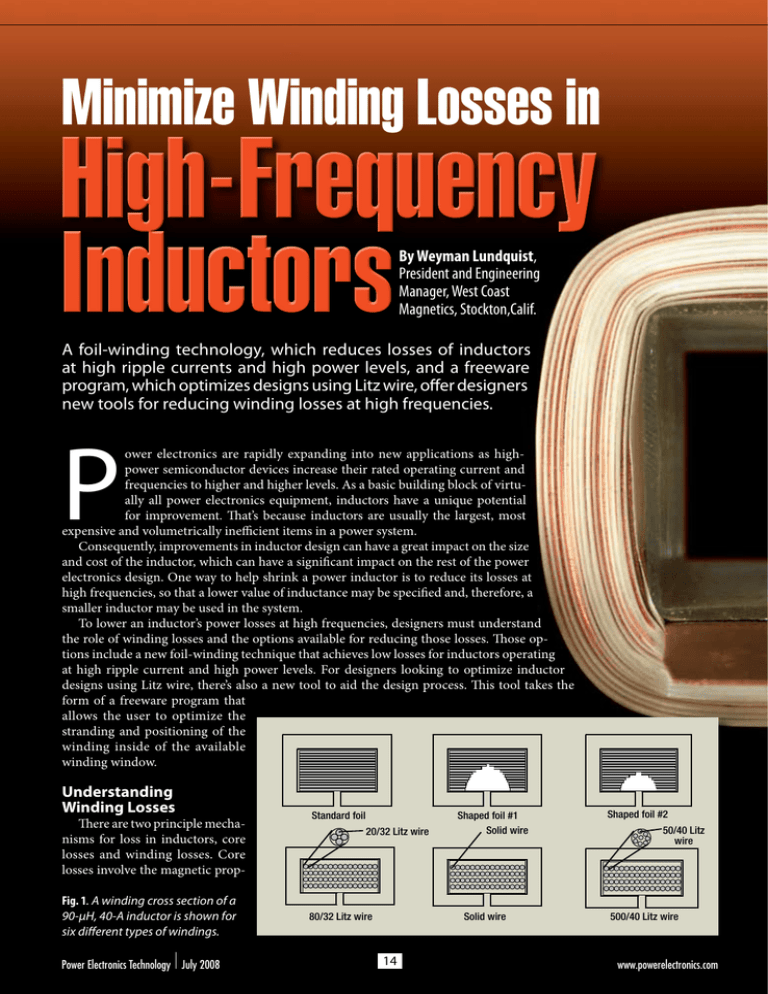
Minimize Winding Losses in High-Frequency Inductors By Weyman Lundquist, President and Engineering Manager, West Coast Magnetics, Stockton,Calif. A foil-winding technology, which reduces losses of inductors at high ripple currents and high power levels, and a freeware program, which optimizes designs using Litz wire, offer designers new tools for reducing winding losses at high frequencies. P ower electronics are rapidly expanding into new applications as highpower semiconductor devices increase their rated operating current and frequencies to higher and higher levels. As a basic building block of virtually all power electronics equipment, inductors have a unique potential for improvement. That’s because inductors are usually the largest, most expensive and volumetrically inefficient items in a power system. Consequently, improvements in inductor design can have a great impact on the size and cost of the inductor, which can have a significant impact on the rest of the power electronics design. One way to help shrink a power inductor is to reduce its losses at high frequencies, so that a lower value of inductance may be specified and, therefore, a smaller inductor may be used in the system. To lower an inductor’s power losses at high frequencies, designers must understand the role of winding losses and the options available for reducing those losses. Those options include a new foil-winding technique that achieves low losses for inductors operating at high ripple current and high power levels. For designers looking to optimize inductor designs using Litz wire, there’s also a new tool to aid the design process. This tool takes the form of a freeware program that allows the user to optimize the stranding and positioning of the winding inside of the available winding window. Understanding Winding Losses There are two principle mechanisms for loss in inductors, core losses and winding losses. Core losses involve the magnetic propFig. 1. A winding cross section of a 90-µH, 40-A inductor is shown for six different types of windings. Power Electronics Technology July 2008 Standard foil 20/32 Litz wire 80/32 Litz wire Shaped foil #1 Solid wire Solid wire 14 Shaped foil #2 50/40 Litz wire 500/40 Litz wire www.powerelectronics.com erties of the core material, which exhibits power losses in the form of hysteresis and eddy currents within the core itself. Winding losses come from the resistance in the winding, typically copper. Inductors used for switch-mode power applications are subject to high-frequency current ripple, which can make the effective winding resistance and the associated copper losses very high. The winding resistance of power inductors includes both the dc resistance and an ac component of resistance that is a result of both skin effects and proximity effects. A time-dependent current induces a flux, which in turn induces small currents within the wire. Since very little current passes through the center of the winding, the effective cross-sectional area is reduced and the resistance is increased. These losses increase in magnitude as the frequency and current increase. At switch-mode frequencies, the ac component of resistance can be very high, often greatly exceeding dc resistance and resulting in high copper losses. With gapped-power inductors, the field near the gap produces a strong local proximity effect and can produce very high ac copper resistance and losses, even leading to the failure of the inductor. Power loss in any magnetic device is the sum of these effects, and the design process is made more difficult by their relationship to one another. For instance, common methods of reducing ac resistance, such as the use of Litz wire, greatly reduce the cross-sectional area of the conductor and drastically increase dc resistance. Foil inductors are often used to minimize winding losses in an application of high dc current, because of their efficient use of the winding window. However, even a small amount of ac current can cause significant losses in these coils. Such sacrifices are unacceptable in many of today’s applications. Many dc-dc converters require an inductor that can carry a large dc current with an ac ripple. Even when the ac component is small in comparison to the dc current, the ac resistance can be orders of magnitude larger than the dc resistance. The problem is more acute as current level and frequency of operation increase in modern designs. Fortunately, there are solutions to the problem of ac copper losses. Keeping the windings to a single layer substantially mitigates ac copper losses. Using a powdered core with no gap will substantially reduce proximity effects and the resulting ac copper losses. However, powdered cores typically have significantly higher core losses than ferrite cores, and for high-ripple applications, a gapped core is sometimes preferred due to lower core losses. Or, it may also be desirable to use a relatively high-permeability powdered core with a gap, to take advantage of the higher BSAT available with this type of core material. In these cases, the gap-fringing field must be dealt with or copper losses can be very high. Shaped-Foil Technology Foil windings are a compelling alternative because of the comparatively high window utilization and very low resulting dc resistance. West Coast Magnetics has worked with the Thayer School of Engineering at Dartmouth to develop a shaped-foil technology[1] that has both low dc and low ac copper losses. The new technology shapes the foil in the vicinity of the gap to use the gap-fringing flux to equalize the current distribution throughout the foil and minimize the skin and proximity effects. An inductor employing this technology combines the very low dc resistance of a copper-foil winding with the low ac resistance of a Litz-wire winding. In particular, for high-current, high-ripple inductors, the shaped-foil 11 500/40 Litz wire 80/32 Litz wire Solid wire 10 Standard foil Shaped foil #1 Shaped foil #2 Power losses (W) 9 8 7 6 5 4 3 0 5 10 15 20 25 30 AC ripple at 50 kHz (%) Fig. 2. A comparison of power losses for inductors using shaped foil conductors versus conventional windings reveals that shaped-foil technology achieves the lowest losses for ripplecurrent values exceeding 10% and at frequencies from 25 kHz up to 500 kHz. 0708PETWCoast_F2 www.powerelectronics.com 15 Power Electronics Technology July 2008 TO POWER YOUR PRODUCTS BETTER PERFORMANCE. BETTER PRICE. GUARANTEED. * * If we can’t improve your Power Magnetics, we’ll give you a $25 STARBUCKS GIFT CARD just for letting us try. sales@magicall.biz www.magicall.biz (805) 484-4300 winding losses winding technology can be the lowestloss solution. An experiment was conducted to compare the new foil technology to conventional windings including solid-wire, Litz-wire and full unmodified-foil windings.[2] For this experiment, a series of 90-µH, 40-A inductors were built and tested using best practices. Each of the prototype inductors was constructed using the same E70/33/32 ferrite core of material EPCOS N67, which had a 2.63-mm gap in the center leg (designated B66371-G-X167). Fifteen turns were wound on all the inductors, producing an inductance of 90 µH to 95 µH. The windings are shown in Fig. 1. In each case, best winding practices were employed, which included singlelayer windings for the Litz and solidwire samples, and in every case, the conductor area was maximized in the winding window. The solid-wire sample consisted of four layers of 10-gauge wire, 15 turns per layer, with the windings connected in parallel. Two Litz-wire samples were constructed, one using 500 strands of 40 AWG Litz wire and the other 80 strands of 32 AWG Litz wire. As with the solid-wire prototype, these inductors were wound in four parallel layers of 15 turns. A standard foil inductor was constructed of 15 turns of 0.020-in. copper, measuring 1.55 in. wide and separated by 0.003 in. 3 1.69 in. of Nomex insulator. Two samples were built using the new shaped-foil technology. One sample had a foil shape optimized for a current of 40 Adc with a 15% (6-A peak-to-peak) ripple at 50 kHz, and the other sample was optimized for a ripple of 22.5% at 50 kHz. The total core and copper losses for each of these inductors were determined experimentally and the results are plotted in Fig. 2. The hatched area illustrates the loss reduction that is observed with the new foil-winding technology versus conventionally wound inductors. Core losses were the same for all the inductors, so the loss reduction is observed in the windings exclusively. 16 Power Electronics Technology July 2008 Wire placement in green, gap at (0, bw/2) 9 8 7 Bobbin breadth (mm) INNOVATIVE MAGNETICS 6 5 4 3 2 1 0 0 1 2 3 Bobbin height (mm) Fig. 3. The ShapeOpt program deter0708PETWCoast_F3 mines the optimal placement of the winding inside the specified bobbin window for a 10.6-µH inductor. Experimental data was collected for these sample inductors at ripple-current values from 1% to 30% and frequencies from 10 kHz up to 500 kHz. This data demonstrates that the shaped-foil technology was the lowest-loss solution for ripple-current values exceeding 10% and at frequencies from 25 kHz up to 500 kHz. Litz-Wire Windings Other work done by the Thayer School of Engineering and West Coast Magnetics has led to advances in the use of Litz wire for winding gappedpower inductors. The field around the gap in a power inductor can be quite strong and create localized losses in windings close to the gap. For a given core and bobbin geometry, it has been shown that there is an optimal solution for Litz-wire stranding and placement inside the bobbin. www.powerelectronics.com winding losses Standard and Custom Power Transformer Solutions Gap 10 9 8 7 6 5 4 3 2 1 0 Wire 0 1 2 3 4 5 hW dimension (mm) 10 9 8 7 6 5 4 3 2 1 0 10 kHz 0 1 2 3 4 5 hW dimension (mm) 50 kHz 10 9 8 7 6 5 4 3 2 1 0 0 1 2 3 4 5 hW dimension (mm) 10 9 8 7 6 5 4 3 2 1 0 Empty 0 1 2 3 4 5 hW dimension (mm) 100 kHz 200 kHz Fig. 4.The ShapeOpt program generates the optimized winding placement for a single inductor as a function of operating frequency. By07008PET_WCoast_F4 choosing the Litz stranding and placement of the winding inside of the bobbin window, it is possible to minimize winding losses. A freeware simulation program called ShapeOpt allows the user to optimize the stranding and positioning of the winding inside of the available winding window. This program is available for use by designers at www.thayer.dartmouth.edu/inductor/ shapeopt. The program is simple to use and the inputs include: l Core-window width and height l Bobbin-window width and height l Ripple-current magnitude and frequency l Gap length l Bobbin-fill factor l Litz-wire strand diameter l Turn length l Number of turns. With this information as input, the program will generate an output detailing the field strength in the bobbin window as well as the ideal placement of the winding in the bobbin window. The program also will determine the total winding losses and choose the number of strands necessary to fill the available window area. By way of example, consider a 10.6-µH inductor operating at 250 kHz with a 4-A rms ripple. This inductor uses an E19/8/5 core with a www.powerelectronics.com 4 Laminated and Toroidal 0.65-mm gap and 13 turns. With a Litz-wire strand diameter of 0.05 mm (44 AWG) selected, ShapeOpt yields an optimal result of 314 total strands and a total winding loss of 0.28 W. Fig. 3 details the placement of the winding inside the bobbin window with the green area being acceptable for winding and the white area being void space. In practice, this bobbin could quickly be prepped with a tape to mask out a rectangular cross section, which closely approximates the result shown in Fig. 3. This type of tape prep is very similar to the margin-tape application widely used to maintain creepage and clearance values to meet isolation requirements in transformers. From this simulation, it can be seen that it is not optimal to completely fill the bobbin with wire. In fact, that approach would result in much higher losses. This problem becomes even more acute as the frequency increases. Fig. 4 is an example of an optimal solution for a single inductor as a function of frequency. As the frequency of the power inductor increases, the placement of the winding inside the core window becomes critical to obtaining the minimumloss solution. Another topic investigated by Thayer researchers using the ShapeOpt 17 Power Transformers, Inductors, and Custom High Frequency Magnetics 4 Capabilities from 0.1 VA to 45 KVA 4 PC and Chassis Mount 4 RoHS-Compliant Products 4 UL, CSA, VDE, IEC, and EN Certified 4 In-House Agency Certification Program 4 Large, Finished Goods Inventory Custom Designs Welcome! PRONTO ® 24 HOUR SHIPPING! Phone: 866/239-5777 Fax: 516/239-7208 Signal Transformer www.signaltransformer.com sales@signaltransformer.com Power Electronics Signal/Power Elec. 2/4/08.indd 1 Technology July2/4/08 2008 9:23:48 AM winding losses 6 5 bW / hW 4 Optimal range for all frequencies 3 2 1 0 EE ETD EC RM PQ Fig. 5. A survey of the ratio of height-to-width for several typical E-core geometries reveals that most of the available cores and bobbins do not have optimal shapes for power inductors using gapped cores. program was the optimal ratio of stranding) and varying the window 07008PET_WCoast_F5 core-winding window height to coreheight to window breadth. When this winding window width. Obtaining is done, some interesting conclusions this optimal ratio involves solving for can be drawn. the total winding losses, while holdAt low frequencies, in the 1-kHz ing two factors constant (windingto 10-kHz range, the optimal ratio of Magnetics Ad half 11_07 1/18/08 11:02 AMto height Page 1is about 1. By windowGeneric perimeter and Litz-wire window width the time the frequency increases to 500 kHz, the optimal ratio of width to height increases to about 2. Comparing this result to the ratio of height to width for several typical E-core geometries (Fig. 5), it quickly becomes apparent that most core and bobbins available on the market today do not have optimal shapes for power inductor designs using gapped cores. References 1. The shaped-foil technology is patented by Dartmouth College, and West Coast Magnetics is a licensee. 2. This experiment was designed by West Coast Magnetics and electrical engineer Jennifer Pollock, Ph.D., of Dartmouth’s Thayer School of Engineering. Professor Charles Sullivan of the Thayer School of Engineering and Ryan Goldhahn, a Duke University Ph.D. candidate, also were involved with the experiment. PETech Strip Wound Cores Tape Wound Cores Bobbin Cores Cut Cores Powder Cores Kool Mu® Cores Molypermalloy Cores High Flux Cores XFLUX™ Ferrite Cores Power Materials High Permeability Materials Special Materials 110 Delta Drive Pittsburgh, Pa 15238 Toll-Free: 1 800 245 3984 Phone: 412 696 1333 Fax: 412 696 0333 Web: www.mag-inc.com Email: magnetics@spang.com Magnetics Hong Kong Asia Sales and Service Phone: +852 3102 9337 Fax: +852 3585 1482 Email: asiasales@spang.com 18 Power Electronics Technology July 2008 www.powerelectronics.com
